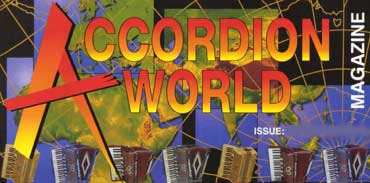
(See our review of Accordion World Magazine) .
The Free-Reed Review
Critiques of Compact Discs, Books and Music Scores

|
The following review was originally published in the September/October 2004 edition of Accordion World magazine
(editor: David Keen). The review was written by Roland Williams and is presented here by the permission of Accordion World. (See our review of Accordion World Magazine) . |
The Classical Accordion
The Sequenzas of Luciano Berio
The Sequenzas of Luciano Berio (1925-2003), the distinguished Italian composer celebrated in a festival of his music in London (15-30 April 2004), are said by some critics to be an achievement in musical thought to stand beside Bach's violin Partitas, Beethoven's last piano sonatas, Paganini's 24 Caprices, Debussy's piano preludes and other instrumental works of the highest technical and intellectual virtuosity. There are 14 of them, each for a different instrument, created by the composer over a period of more than 40 years of his working life as a composer. All 14 of them were performed in concerts in the week long celebratory festival in which a very large amount of all the composer's work was performed.
Sequenza XIII, which Berio calls 'Chanson', an improvisation, a rondo ('a memory looking to the future') was written in 1995 for the accordion. The dedicatee of the work was the Italian accordionist Teodora Anzellotti who gave a masterly performance of it in concert at the Royal Festival Hall Purcell Room on Saturday 24th April. The other works in the programme were the sequenzas for alto saxophone, violin and guitar. It is indeed a mark of the enhanced status of the accordion amongst the musical elite that it appears as one of the works in this series and therefore an event of some importance.
Part of the festival consisted of a series of master classes, lectures and films on Berio's life and work. The master class on the Accordion Sequenza was given by Anzellotti the day before the Purcell Room concert and the student was Milos Milivojevic. It has to be said that this was a much less successful event from an audience point of view than the concert performance through no fault of the student Milos Milivojevic, who always responded well in the class to Anzellotti s suggestions for performance of the piece. Anzellotti made no attempt to give the audience an overall view of the work, to explain his own relationship with Berio or any general musical analysis of Berio's aims in the series and their application to the accordion. In fairness one should say that general points did emerge in the detailed discussion of the first few pages of the text (mainly in Italian through an interpreter on stage), but it was an opportunity partially missed. Effectively Anzellotti gave a private lesson on part of the work in front of a full audience and not a master class.
The first of Berio's Sequenzas, for flute, was composed in 1958 and Chanson for accordion was almost the last (No.XIII). Only the Sequenza for cello (No.XIV) composed in 2002 comes after it. Berio's views on musical instruments are interesting. He argues that composers cannot and should not try to invent instruments or alter them. He is scathing about alterations to the flute and John Cage's work for 'prepared piano'.) He argues nevertheless that a composers work can 'transform' conventional conceptions of an instrument and its musical possibilities and this is what he sets out to do in most of his Sequenzas. He says of them that his '...ideal was the polyphonic melodies of Bach.' Through this he says he wanted to suggest throughout 'a polyphonic mode of listening' even for instruments like the flute or violin, that are not polyphonic.
How does Berio apply this thinking in the case of his accordion Sequenza? The free bass accordion is already polyphonic and has been an instrument as he says 'in continuous growth' although it has many musical associations, which he wishes to disregard. Chanson begins with a very simple and very short melody (only a few bars) but the polyphonic texture of the development soon makes it complex and one hears the tune expressed in different ways through intricate contrapuntal writing. The tempo throughout is Moderato but the technical difficulties for the performer, with sharp variations in dynamics and underlying tension and complex polyphonic writing with overlapping trills in both hands, are considerable. Interestingly Berio does not necessarily intend his performers to play his works exclusively with other 'modern' music. I have no time for the modern music specialist, he says. Part of the intellectual challenge to a modem virtuoso is to face the problem of performance of works spanning the 18th to the 20th century.
Berio's views are often controversial but also very interesting. The book 'Luciano Berio, Two Interviews with Rossana Dalmonte and Balint Andras Varga' is recommended for its stimulating general discussion of music. (Published by Marion Boyars). All the Sequenzas (except that for cello) are available as a boxed set of 3 CD's published (with a booklet with notes by the composer himself) by Deutsche Grammophon (Sequenza No.XIII is played by Teodora Anzellotti.)
Roland Williams